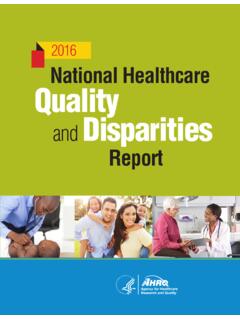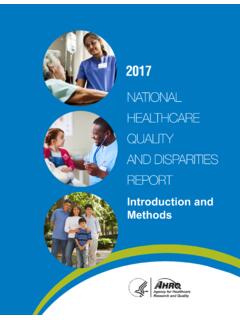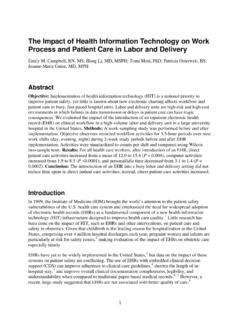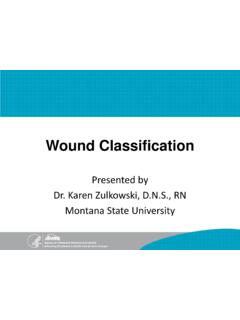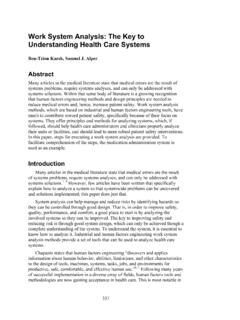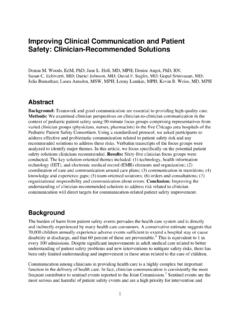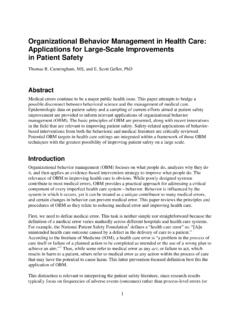Transcription of The Impact of Standardized Order Sets on Quality and ...
1 The Impact of Standardized Order sets on Quality and Financial Outcomes David J. Ballard, MD, MSPH, PhD; Gerald Ogola, MS, MPH; Neil S. Fleming, PhD; Dave Heck, MD; Julie Gunderson, RN, BSN, MM ; Raaj Mehta; Roger Khetan, MD; Jeffrey D. Kerr, MD Abstract Objective: The objective of this project was to valuate Impact of a Standardized Order set on Quality and financial performance. Methods: We conducted an observational study to examine Order set use by hospital, discharge month, severity of illness and risk of mortality for pneumonia patients between March 2006 and September 2007. We also assessed Impact on in-hospital mortality and 30-day readmission rates using four measures: (1) Cox proportional hazards regression, (2) Joint Commission Core Measures compliance using logistic regression, (3) length of stay, and (4) financial indicators using robust regression methods for highly skewed data.
2 Results: A total of 3,301 patients met the inclusion criteria. Over 19 months, Order set use increased by 55 percent. Order set use significantly improved in-hospital mortality [hazard ratio (95 percent confidence interval (CI): ( ; ) or ( ; ); and Core Measures compliance (relative risk, 95 percent CI: ( ; ) or ( ; )] following covariate or propensity score risk adjustment. Conclusion: Evidence-based pneumonia Order sets can reduce inpatient mortality and increase delivery of important care processes. Introduction Baylor Health Care System (BHCS), an integrated health care delivery system located in North Texas, is engaged in a multiyear process and organizational redesign project that includes the implementation of an electronic health record (EHR) system supporting computerized physician Order entry (CPOE) and point-of-care decision support.))
3 This process is intended to increase the overall standardization, Quality , and efficiency of care. As an intermediate step partly to achieve some of the Quality of care benefits associated with the standardization and streamlining of care offered by CPOE, and partly to familiarize physicians with the use of Standardized orders BHCS is developing system-wide Standardized Order sets to be made available through the physician intranet portal at all BHCS locations. Ultimately, these Order sets will serve as the core library of Order sets supporting the CPOE system. Since its introduction in 2001, the intranet physician portal has provided secure access to patient health information from any location via the BHCS Network.
4 Using the portal to disseminate Order sets simplifies the process of applying updates universally in a timely manner and eliminates the need to provide printed copies at all physical locations. Additionally, this system introduces an intermediate level of computer use, which is intended to ease the transition from 1handwritten orders to CPOE. The Medical University of South Carolina pursued a similar strategy and reported success, both in attaining some CPOE-related benefits before implementing a full CPOE application and in achieving some of the cultural changes necessary for the successful implementation of Previous research suggests that implementation of Standardized Order sets , templates, or protocols can improve compliance with recommended processes of care such as early administration of aspirin, prescription of angiotensin converting enzyme inhibitors, and use of -blockers for acute myocardial patients,2, 3, 4, 5.
5 6 and improve patient The Impact of such tools on resource use appears more variable, depending in part on the clinical area or type of care targeted. For instance, introduction of Standardized Order sets , care protocols, or critical pathways has been found to reduce overall length of stay, postoperative length of stay, and total charges for multiple surgical procedures, including total knee arthroplasty,7 appendectomy,8 total laryngectomy,9 cholecystectomy,10 carotid endarterectomy,11 gastrectomy,12 inguinal hernia repair,13 and colon In contrast, interventions to standardize treatment of conditions requiring inpatient medical rather than surgical management such as pneumonia,15, 16, 17 congestive heart failure.
6 13 and conservative management of acute appendicitis8 have had variable effects on length of stay and costs. BHCS is in the process of developing and implementing more than 50 Standardized Order sets in a variety of clinical areas. The first of these the adult pneumonia Order set was made available system-wide through the physician intranet portal in 2006. We investigated the effect of this Order set on in-hospital mortality, compliance with evidence-based recommendations for pneumonia care, length of stay, cost of care, and fiscal operating margin. Methods Study Setting BHCS is a not-for-profit, multihospital system in Dallas-Fort Worth, TX, that incorporates 20 owned, leased, affiliated, and short-stay hospitals with an annual total of more than 103,000 admissions.
7 Only the eight acute care hospitals, where most patients with community-acquired pneumonia are treated, were included in this study. BHCS is engaged in a multiyear process and organizational redesign project that is supported by the implementation of health information technology. The long-term goals for this project include: Creating a culture that fosters interdisciplinary collaboration. Eliminating unnecessary variability in patient care. Developing and deploying the best evidence-based operational and clinical models. Providing clinical decision support at the point of care. Providing caregivers with the opportunity to spend more time with patients.
8 Significantly improving Quality and reducing errors. 2 The first phase of this redesign project has been paper-based for the most part, predominantly involving the establishment of monitoring and feedback systems to track performance on Quality indicators that facilitate the design and implementation of targeted Quality improvement initiatives. These indicators include clinical preventive services delivery in the ambulatory care setting and Joint Commission Core Measures in the hospital setting. Introduced in 2004, the accelerating Best Care at Baylor (ABC Baylor) class was designed to teach physicians, hospital administrators, nurse managers, and others the skills needed to actively lead Quality improvement efforts and to facilitate process redesign.
9 The second phase of this multiyear project, currently ongoing, involves the standardization of care and the practice of evidence-based medicine through the development and implementation of Standardized Order sets and protocols. Although these tools are essentially paper-based, increasing technologic support ( , Order set deployment via the intranet physician portal) is being introduced. The third phase will involve the implementation of EHRs and CPOE, which will integrate the process redesign and Order sets introduced during earlier phases. Development of Order sets The identification of the most necessary Order sets has been based on Diagnosis Related Group (DRG) data (particularly patient volumes), the Institute of Medicine s 20 Priority Areas,18 BHCS performance on the Joint Commission Core Measures,19 and information from individual service lines ( , vascular, oncology, and radiology) about areas in which they feel the use of Standardized Order sets would have the greatest potential to improve Quality of care.
10 The available evidence is reviewed, and a straw model is developed once a condition or procedure is identified as a target for a Standardized Order set. Appropriate leaders, physician champions ( , clinicians with dedicated BHCS-funded time for promoting Quality improvement initiatives within BHCS), and other care providers and staff are identified and recruited for the development team. Sources used to identify the available evidence have included the National Library of Medicine, the Baylor Health Science Library, the Cochrane Database of Systematic Reviews, EMBASE, the University of Toronto Center for Evidence-Based Medicine, the Agency for Healthcare Research and Quality (AHRQ) Evidence-Based Practice Center program, the AHRQ National Guideline Clearinghouse (NGC), UpToDate , and Zynx.
